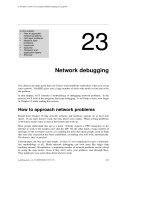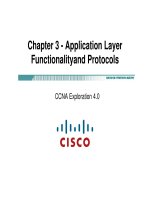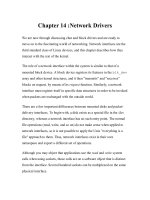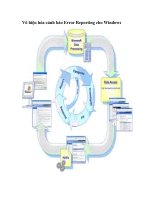Chapter 21 Network Layer: Address Mapping, Error Reporting, and Multicasting pdf
Bạn đang xem bản rút gọn của tài liệu. Xem và tải ngay bản đầy đủ của tài liệu tại đây (943.36 KB, 55 trang )
21.1
Chapter 21
Network Layer:
Address Mapping,
Error Reporting,
and Multicasting
Copyright © The McGraw-Hill Companies, Inc. Permission required for reproduction or display.
21.2
21-1 ADDRESS MAPPING
21-1 ADDRESS MAPPING
The delivery of a packet to a host or a router requires
The delivery of a packet to a host or a router requires
two levels of addressing:
two levels of addressing:
logical
logical
and
and
physical
physical
. We need
. We need
to be able to map a logical address to its corresponding
to be able to map a logical address to its corresponding
physical address and vice versa. This can be done by
physical address and vice versa. This can be done by
using either static or dynamic mapping.
using either static or dynamic mapping.
Mapping Logical to Physical Address
Mapping Physical to Logical Address
Topics discussed in this section:
Topics discussed in this section:
21.3
Figure 21.1 ARP operation
21.4
Figure 21.2 ARP packet
21.5
Figure 21.3 Encapsulation of ARP packet
21.6
Figure 21.4 Four cases using ARP
21.7
An ARP request is broadcast;
an ARP reply is unicast.
Note
21.8
A host with IP address 130.23.43.20 and physical address
B2:34:55:10:22:10 has a packet to send to another host
with IP address 130.23.43.25 and physical address
A4:6E:F4:59:83:AB. The two hosts are on the same
Ethernet network. Show the ARP request and reply
packets encapsulated in Ethernet frames.
Solution
Figure 21.5 shows the ARP request and reply packets.
Note that the ARP data field in this case is 28 bytes, and
that the individual addresses do not fit in the 4-byte
boundary. That is why we do not show the regular 4-byte
boundaries for these addresses.
Example 21.1
21.9
Figure 21.5 Example 21.1, an ARP request and reply
21.10
Figure 21.6 Proxy ARP
21.11
Figure 21.7 BOOTP client and server on the same and different networks
21.12
DHCP provides static and dynamic
address allocation that can be
manual or automatic.
Note
21.13
21-2 ICMP
21-2 ICMP
The IP protocol has no error-reporting or error-
The IP protocol has no error-reporting or error-
correcting mechanism. The IP protocol also lacks a
correcting mechanism. The IP protocol also lacks a
mechanism for host and management queries. The
mechanism for host and management queries. The
Internet Control Message Protocol (ICMP)
Internet Control Message Protocol (ICMP)
has been
has been
designed to compensate for the above two deficiencies.
designed to compensate for the above two deficiencies.
It is a companion to the IP protocol.
It is a companion to the IP protocol.
Types of Messages
Message Format
Error Reporting and Query
Debugging Tools
Topics discussed in this section:
Topics discussed in this section:
21.14
Figure 21.8 General format of ICMP messages
21.15
ICMP always reports error messages to
the original source.
Note
21.16
Figure 21.9 Error-reporting messages
21.17
Important points about ICMP error messages:
❏ No ICMP error message will be generated in
response to a datagram carrying an ICMP error
message.
❏ No ICMP error message will be generated for a
fragmented datagram that is not the first fragment.
❏ No ICMP error message will be generated for a
datagram having a multicast address.
❏ No ICMP error message will be generated for a
datagram having a special address such as
127.0.0.0 or 0.0.0.0.
Note
21.18
Figure 21.10 Contents of data field for the error messages
21.19
Figure 21.11 Redirection concept
21.20
Figure 21.12 Query messages
21.21
Figure 21.13 Encapsulation of ICMP query messages
21.22
Figure 21.14 shows an example of checksum calculation
for a simple echo-request message. We randomly chose
the identifier to be 1 and the sequence number to be 9.
The message is divided into 16-bit (2-byte) words. The
words are added and the sum is complemented. Now the
sender can put this value in the checksum field.
Example 21.2
21.23
Figure 21.14 Example of checksum calculation
21.24
We use the ping program to test the server fhda.edu. The
result is shown on the next slide. The ping program sends
messages with sequence numbers starting from 0. For
each probe it gives us the RTT time. The TTL (time to
live) field in the IP datagram that encapsulates an ICMP
message has been set to 62. At the beginning, ping defines
the number of data bytes as 56 and the total number of
bytes as 84. It is obvious that if we add 8 bytes of ICMP
header and 20 bytes of IP header to 56, the result is 84.
However, note that in each probe ping defines the
number of bytes as 64. This is the total number of bytes in
the ICMP packet (56 + 8).
Example 21.3
21.25
Example 21.3 (continued)









